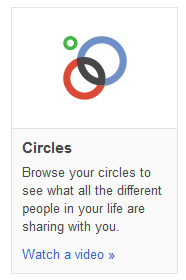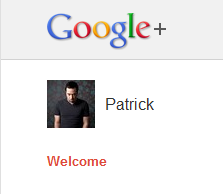Google+: It’s All About Circles
 TL;DR version:
TL;DR version:
The killer feature in Google+ is Circles, and it’s pretty damn awesome. It’s a true innovation for social media, just as Twitter’s “following” system was when all we knew was “mutual friending”.
Ok, long version:
(If you don’t know anything about Google+, scroll down for a more in depth description.)
Circles might seem like a simple concept, but they’re actually an incredibly powerful idea. Essentially, they are a mix between Facebook’s and Twitter’s ideas of what a social graph is. They are a very clever blend of the “friending” and “following” systems. With Circles, when you “add” someone to your social graph, you have to decide which Circle(s) you add them to. You can’t just “follow” someone, you follow them by adding them to one of your Circles. From then on, you will only see their updates when you’re looking at that specific circle’s feed (or at your “full” feed, which includes all the people in your various Circles).
Simple, right? “Yeah, that’s just Facebook’s friend grouping” you’ll say. Not really. This is actually much more ingenious. Here’s why:
- Let’s say I add Tom Merritt only to my “Beards” circle, but Tom hasn’t added me to any of his Circles (he doesn’t “follow” me).
- Tom sends a public update. I will see it in my “Beards” feed (and my full “everyone I follow” feed).
- Since Tom hasn’t added me to any of his Circles (he doesn’t follow me), he will never see any of my updates.
- Now let’s say Tom adds me to his “Frenchies” Circle, but not to his “USAns” Circle.
- He will see my updates in his Frenchies feed, as well as his full feed. But not if he looks at his USAns feed.
- Now the key thing is, you can also restrict an update to be sent only to one or more of your Circles.
- Remember, Tom has added me to his Frenchies Circle but not his USAns Circle.
- If Tom sends an update to his Frenchies Circle, I will see it.
- If he sends an update to his USAns Circle, I won’t see it.
- Also important to know: people don’t see which Circle you’ve put them in. That is for your eyes only.
So you could think of it as Twitter lists on steroids, where lists go both ways. Again, this is really powerful stuff, with deep implications. It means that when you use Google+, you don’t have to choose between a public and a private tool / site / network / social space. With one system, you can direct your updates to the people you want, without forcing anything unto anyone. It basically blends the best parts of Facebook and Twitter together (including status updates, lists, fan pages, etc).
The downside is that lists are annoying to manage, and ultimately this might be a reason why Google+ stays constrained to a subset of the online population. Indeed, Zuckerberg was right when he stated that people don’t want to manage lists (Twitter lists didn’t really take off in a big way either). Sure, playing with those widgets is fun for us geeks, but I don’t think Aunt Edna will like it all that much (or even understand it).
That being said, Google’s Circles interface seems to make the “list sorting experience” as painless as can be, so who knows, maybe enough people will make the effort. Especially since Circles control everything in the system: Hangouts can be open to a specific one, Huddles work in the same way, and everything you do on the network can be restricted to one or more of them (updates, photos, links, etc). Again, I think we might see Facebook copying this feature very very quickly…
And for those who want to know more about the service as a whole…
 Google+ has taken the tech world by storm in the past 36 hours. Some experts are saying this is the most important Google product launch since Android, and anyone who has a brain agrees. Many are skeptical of the search giant’s capacity to compete in that space of course, and given the spectacular failures of Wave and Buzz, who would blame them? But this new thing definitely has a much much greater potential, and it seems that those who have tried it are all reasonably impressed.
Google+ has taken the tech world by storm in the past 36 hours. Some experts are saying this is the most important Google product launch since Android, and anyone who has a brain agrees. Many are skeptical of the search giant’s capacity to compete in that space of course, and given the spectacular failures of Wave and Buzz, who would blame them? But this new thing definitely has a much much greater potential, and it seems that those who have tried it are all reasonably impressed.
Let’s be clear: it won’t overtake Facebook overnight. Actually, it might very well never do that at all. But it doesn’t really need to. Social media is big, and there is definitely room for another player (especially if its name begins with G and ends with oogle). Facebook frustration runs high, and the mere fact that it is a viable alternative could be reason enough to switch for many.
Also, Google+ has a few very interesting features, which make it noticeably different from Zuckerberg’s privacy challenged brainchild. Overall, I wouldn’t be surprised if Google+ become a serious player in the social space, with dozens of millions of accounts by year’s end. Which would already be a resounding success…
Description time! If you want to know what Google+ is in one idea, you can see it as a social network eerily similar to Facebook, but with a few very key differences. Here’s a quick, non exhaustive list:
- Cleaner look. Before you scoff at this, remember that the look was an important factor in what made people switch to Facebook from Myspace (which lovely star ridden design I often called “the bane of the Internets”). I have to say, after using Google+ for just a few hours, Facebook’s design did start looking a bit cluttered and confused to me. I never really realized that… until now.
Sure enough, some things could be tweaked. Namely, the sections and fonts are a bit large, and it’s easy to miss something into the ether if you’re not paying attention (the feeds are more Twitterish than Facebookish at the moment, if this means anything). But still, Google engineers like minimalistic design, and it shows. - Hangouts. These are absolutely awesome. It’s video chat done right: you open up a room to one of your Circles, and people go in and out as they please. You see all participants at the bottom (up to ten) and the one speaking appears in a large video on the top. Super simple, but it just works and it’s incredibly fun. You can also “share” a YouTube video to watch together. I can only imagine how it will evolve (watching movies, listening to music, playing games, sharing documents…). This is probably the coolest feature in there, and it’s full of possibilities. Collaboration, education, support and more.
It’s kind of a more intimate version of Tinychat, for those who’ve used it, and must be making Skype reasonably uncomfortable right now. Also, I wouldn’t be surprise to see something similar appear in Facebook very quickly. - Sparks. Not really worth talking about too much: gives you “news” based on your interests (and your friends’ votes maybe?) but it seems a bit broken at the moment. Results are poor at best, and a quick Google Search gives better results. Might turn into something later (good discovery potential), but for now it’s kind of a bleh (<- most wordy description I could muster).
- Huddle (Mobile app only): it’s a group chat. I don’t have an Android phone and the iOS app isn’t out yet so I haven’t tried it, but it seems straight forward enough. Also takes advantage of Circles, although that use could be a bit more tricky if your Circles become too big.
- Instant Photo Uploads. Also for Android phones, there is an “auto upload” feature for photos which is pretty cool. If you activate it, all the pictures you snap from your phone are instantly uploaded to a safe place on your account, and displaying them is just a click away. I doubt that’ll come to iOS though (system restrictions).
- There is more, but this will have to do for now.
All in all, my view of Google+ is that Circles are an immensely clever and powerful way to tackle the control problem in social graphs, and that Hangouts are really really fun.
Now whether or not Google+ will take off as a whole is a different matter of course. There are issues already (and more to come I’m sure) but let’s be fair: it launched yesterday, it’s still in “field testing”, and it’s already in great shape. We also have to recognize that Google learned from its mistakes, and seems to be doing a lot of things right this time: measured launch, strong privacy control, deep but controlled integration with email and other services… Google+ is a very strong service already. And given how crucial social media has become, this is indeed an important vent in the tech world.
So my conclusion is this: Google is off to a very good start and could have a winner on its hands. I won’t get carried away and tell tales of industry changes and such, but what I will say is that I’m convinced enough to keep using it for the time being. And given my experience with Google’s social endeavors, that wasn’t a given.
PS: No one seems to have invites at this point. They were open for a few hours yesterday but seem to be closed, because of “insane demand“. If I do get enough to pass around somewhere down the line (before everyone and their mother has one), I’ll make sure to update this post and offer some to as many people as I can.

